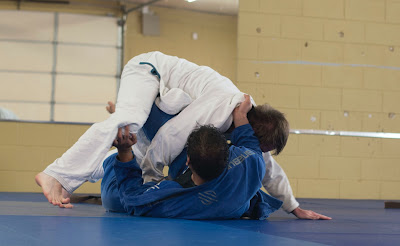Welcome to the enthralling world of martial arts history, where we embark on a journey through time to unravel the evolution and impact of a specific form of martial art.
In this article, we delve into the fascinating history and far-reaching influence of Brazilian Jiu-Jitsu (BJJ). From its humble origins in Japan to its global prominence as a combat sport and self-defence system, BJJ has left an indelible mark on the martial arts landscape.
Join us as we explore the story of Brazilian Jiu-Jitsu and its profound effects on both the world of fighting and the broader realm of personal development.
The Origins of Brazilian Jiu-Jitsu
Our journey begins in Japan, where the roots of Brazilian Jiu-Jitsu can be traced back to the samurai and their ancient combat systems.
The Japanese martial art of Jujutsu, with its focus on using leverage and technique to overcome larger opponents, laid the groundwork for what would later become BJJ.
In the late 19th century, a Japanese Jujutsu master named Jigoro Kano developed Judo, emphasizing the use of efficient techniques and groundwork. It was Kano's emphasis on refining and adapting traditional techniques that would prove instrumental in the evolution of Brazilian Jiu-Jitsu.
Impactful Figure - Mitsuyo Maeda
One of the key figures in the history of Brazilian Jiu-Jitsu is Mitsuyo Maeda, a Japanese Judo and Jujutsu expert who travelled the world demonstrating his martial skills.
Maeda's journey took him to Brazil, where he encountered a young Carlos Gracie. Maeda's teachings and techniques left a profound impression on Carlos and his family, igniting the spark that would lead to the birth of Brazilian Jiu-Jitsu.
The Birth of Brazilian Jiu-Jitsu
In the early 20th century, Carlos Gracie and his brother Helio Gracie, both of whom had trained with Maeda, began developing their own unique style of martial art.
This style would eventually become known as Brazilian Jiu-Jitsu, with an emphasis on ground fighting, submissions, and leverage-based techniques.
One of the defining characteristics of BJJ is its focus on practicality and adaptability.
The Gracie family, through rigorous testing and real-world combat experience, refined their techniques to create a martial art that could be used effectively in self-defence and competition.
The Evolution of BJJ
Brazilian Jiu-Jitsu continued to evolve in Brazil, with the Gracie family at the forefront of its development. They established the first BJJ academies and began to promote the art through challenge matches and tournaments.
In the 1970s and 1980s, Brazilian Jiu-Jitsu made its way to the United States, thanks to figures like Rorion Gracie and his creation of the Ultimate Fighting Championship (UFC).
BJJ practitioners demonstrated the effectiveness of their art in no-holds-barred fights, showcasing their ability to defeat larger opponents through technique and strategy.
Impactful Figure - Royce Gracie
Royce Gracie, one of the most prominent members of the Gracie family, played a pivotal role in popularizing Brazilian Jiu-Jitsu in the United States. He achieved fame by winning multiple UFC tournaments against much larger opponents, highlighting the art's effectiveness in real combat situations.
Brazilian Jiu-Jitsu Today
Today, Brazilian Jiu-Jitsu has become a global phenomenon, with practitioners and academies spread across the world. BJJ has made significant inroads in the world of martial arts and combat sports, leaving a lasting impact in several key areas -
1. Mixed Martial Arts (MMA)
BJJ techniques have become an integral part of MMA, with fighters using BJJ skills to control opponents, submit them, or escape dangerous situations. Many MMA champions have a strong background in Brazilian Jiu-Jitsu.
2. Self-Defense
BJJ's focus on practical self-defence techniques has made it a popular choice for individuals seeking effective ways to protect themselves in real-world situations. Women and men alike have embraced BJJ for its empowering self-defence capabilities.
3. Physical Fitness
BJJ offers an exceptional workout that combines cardiovascular conditioning, strength training, and flexibility. It has attracted people looking to improve their fitness and overall well-being.
4. Competition
Brazilian Jiu-Jitsu has a thriving competitive scene, with tournaments held worldwide. The sport has its own set of rules and ranks, and practitioners can compete at various levels, from local events to international championships.
5. Mental Discipline
BJJ promotes mental discipline and problem-solving, as practitioners learn to strategize and adapt during sparring sessions. It fosters resilience and the ability to remain calm under pressure.
Final Thoughts
In conclusion, Brazilian Jiu-Jitsu, born from the ancient traditions of Japanese martial arts, has undergone a remarkable transformation and global expansion. From its humble beginnings in Brazil to its prominent role in MMA, self-defence, and fitness, BJJ has left an indelible mark on the world of martial arts.
The Gracie family's dedication to refining and promoting their art has paved the way for countless individuals to learn and benefit from Brazilian Jiu-Jitsu. Its emphasis on technique, leverage, and adaptability has transcended cultural and geographical boundaries.
As we reflect on the history and impact of Brazilian Jiu-Jitsu, we recognize not only its influence on the world of combat sports but also its contribution to personal development and empowerment.
It is a martial art that continues to evolve, inspiring practitioners to push their physical and mental boundaries while fostering a deep sense of respect and camaraderie within its global community.
Edited by - Simran Mahon
This article has been authored exclusively by the writer and is being presented on Eat My News, which serves as a platform for the community to voice their perspectives. As an entity, Eat My News cannot be held liable for the content or its accuracy. The views expressed in this article solely pertain to the author or writer.









0 Comments